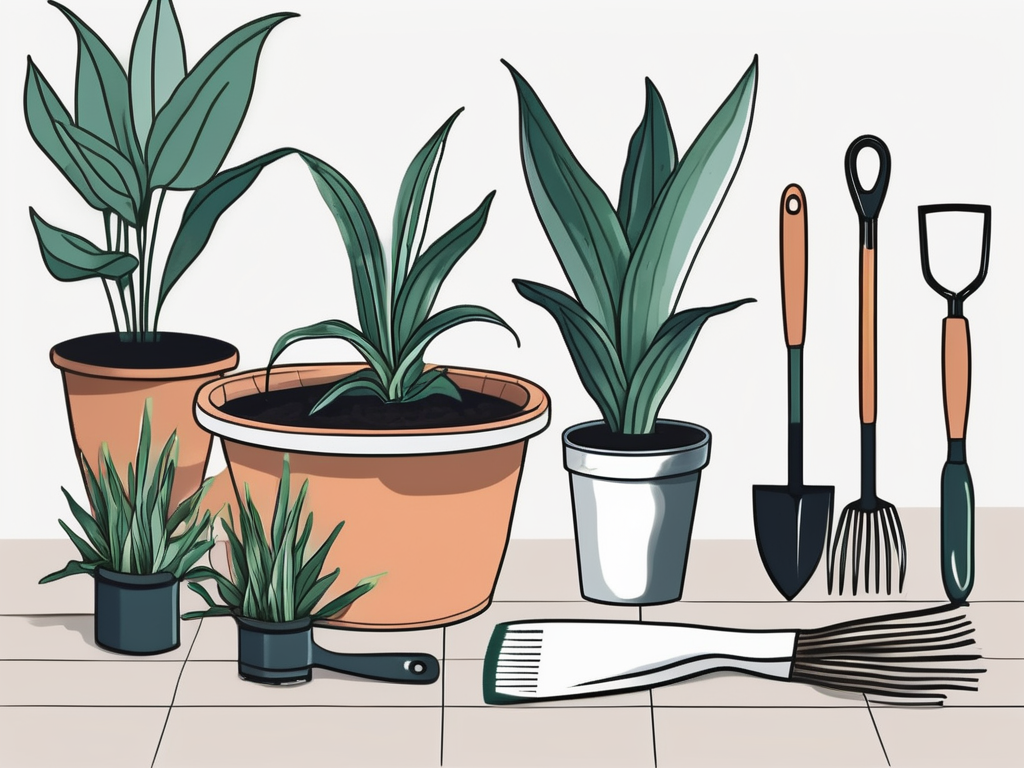
Have you ever found yourself captivated by the striking beauty of the Whale Fin Snake Plant? With its bold, architectural leaves, it's no wonder this plant has become a favorite among plant lovers. But, like any living thing, it has its needs. One of the most important tasks in keeping your Whale Fin Snake Plant happy and healthy is repotting it at the right time and in the right way.
This article will guide you through the entire repotting process. We'll cover everything from recognizing when it's time to repot, choosing the right pot and soil, and step-by-step instructions on how to do it. Plus, we'll share some tips on post-repotting care to ensure your plant thrives in its new home. Grab your gardening gloves, and let's get started!
Recognizing When Your Whale Fin Snake Plant Needs Repotting
Before you jump into repotting, it's crucial to determine if your plant actually needs it. Unlike some plants that require frequent repotting, the Whale Fin Snake Plant is relatively low-maintenance in this regard. However, there are a few signs that indicate it's time for a new pot.
Here are some common indicators:
- Roots Peeking Out: If you see roots coming out of the drainage holes or circling the surface of the soil, it's time to upgrade the pot.
- Slow Growth: While Snake Plants are not the fastest growers, if yours seems to have stalled, it might be root-bound and in need of more space.
- Water Retention Issues: If your plant's soil is retaining water longer than usual, or if water runs straight through, the current soil may be compacted, signaling a need for fresh soil.
Interestingly enough, Whale Fin Snake Plants prefer being slightly root-bound, so you don't need to rush into repotting every year. Typically, repotting every two to three years is sufficient.
Choosing the Right Pot
Once you've determined that your plant needs repotting, the next step is to select the perfect pot. The right pot will not only accommodate the plant's growth but also complement your interior décor.
Here are a few tips to keep in mind when choosing a pot:
- Size Matters: Opt for a pot that's 1-2 inches larger in diameter than the current one. Going too large can lead to water retention issues, which can suffocate the roots.
- Material Options: Terracotta pots are popular for Snake Plants because they are breathable and help prevent overwatering. However, any material with good drainage will work fine.
- Drainage Holes: Make sure the pot has adequate drainage holes to allow excess water to escape, preventing root rot.
Your pot choice can also reflect your personal style. Whether you prefer a minimalist white ceramic pot or a rustic terracotta one, ensure it matches your home's vibe as well as the plant's needs.
Selecting the Best Soil
Now, let’s talk about soil. The right soil mix is essential for the health of your Whale Fin Snake Plant. These plants prefer a well-draining soil mix to prevent root rot, a common issue with overwatering.
Here are some soil mix suggestions:
- Cactus or Succulent Mix: These are typically well-draining and mimic the plant’s natural habitat.
- Homemade Mix: Combine equal parts potting soil, perlite, and sand to create a custom mix that drains well.
- Avoid Heavy Soils: Stay away from dense, moisture-retentive soils that can cause waterlogging.
If you're feeling adventurous, you can experiment with different soil blends to see what your plant prefers. Just make sure it remains airy and free-draining.
Preparing to Repot
With your pot and soil ready, it's time to prepare for the actual repotting process. This stage involves gathering your tools and setting up a workspace where you can work comfortably and safely.
Here’s a checklist of what you’ll need:
- Potting Soil: Your chosen soil mix.
- Pot: The new pot with drainage holes.
- Garden Trowel: For scooping soil.
- Gloves: To protect your hands from dirt and potential irritation from the plant's sap.
- Old Newspapers or a Tarp: To catch any soil spills and make cleanup easier.
Before you start, water your plant lightly a day or two in advance. This makes the soil easier to work with and reduces stress on the plant.
Step-by-Step Repotting Instructions
Now comes the exciting part – repotting your Whale Fin Snake Plant! Follow these steps to ensure a smooth transition for your plant:
- Remove the Plant: Gently turn the pot on its side and carefully slide the plant out. You may need to tap the sides of the pot to loosen the soil.
- Inspect the Roots: Check for any signs of root rot or damage. Healthy roots should be firm and white.
- Trim if Necessary: Prune away any rotten or damaged roots using sterilized scissors.
- Place in New Pot: Add a layer of soil to the bottom of the new pot, then position your plant in the center.
- Fill with Soil: Gradually fill the pot with soil, pressing lightly to eliminate air pockets, but don’t pack it too tightly.
- Water Thoroughly: Give your plant a good watering to help it settle into its new home.
And there you have it! Your Whale Fin Snake Plant is now snug in its new pot, ready to continue growing and thriving.
Post-Repotting Care
After the repotting process, your plant will need some time to adjust to its new environment. Here are some tips to help your Whale Fin Snake Plant settle in:
- Location: Place your plant in a spot with bright, indirect light. Avoid direct sunlight as it can scorch the leaves.
- Watering: Hold off on watering too often initially. Allow the soil to dry out between waterings to prevent overwatering.
- Humidity: Whale Fin Snake Plants are not too fussy about humidity, but maintaining moderate humidity levels can be beneficial.
Monitor your plant closely for the first few weeks. Any drooping or yellowing leaves might indicate stress, but with proper care, your plant will bounce back.
Common Missteps and How to Avoid Them
Repotting can be a bit daunting, especially if you're new to plant care. Here are some common mistakes people make and how to steer clear of them:
- Overpotting: Picking a pot that's too large can lead to overwatering issues. Stick to pots that are 1-2 inches larger in diameter.
- Overwatering Post-Repotting: Remember, your plant is adjusting, so go easy on the watering. Let the soil dry out between waterings.
- Skipping the Root Check: Always inspect the roots for signs of rot or disease. It’s easier to treat problems when caught early.
By staying mindful of these pitfalls, you can ensure a smooth repotting experience for both you and your plant.
Incorporating Your Whale Fin Snake Plant into Home Décor
With your Whale Fin Snake Plant freshly repotted, it’s time to think about where it will live in your home. This plant is not just a pretty face; it's a statement piece that can enhance any space.
Consider these ideas for incorporating it into your home décor:
- Accent Piece: Use it as a focal point in your living room or hallway. Its unique shape and size make it a natural attention-grabber.
- Group with Other Plants: Create a mini indoor garden by grouping it with other plants with varying heights and textures.
- Stand-Alone Statement: If you prefer a minimalist look, let your Whale Fin Snake Plant stand alone in a stylish pot.
This plant's architectural form and striking patterns can complement modern, bohemian, or even traditional décor styles.
Frequently Asked Questions About Repotting
It's normal to have questions, especially if you're new to plant care. Here are some common queries about repotting Whale Fin Snake Plants:
- How often should I repot my Whale Fin Snake Plant? Generally, every two to three years is sufficient unless you notice the plant becoming root-bound earlier.
- Can I use regular potting soil? While you can, it's better to mix it with sand or perlite to improve drainage.
- What if I damage some roots during repotting? Don't worry – most plants can recover from minor root damage. Just give it some extra care and time to heal.
Having a good understanding of these aspects can make the process less intimidating and more enjoyable.
Final Thoughts
Repotting your Whale Fin Snake Plant doesn't have to be a daunting task. With the right tools, a little patience, and the steps we've outlined, you can give your plant the fresh start it needs to thrive. Remember, the key is to be observant and responsive to your plant’s needs.
At Cafe Planta, we’re passionate about helping you succeed in your plant journey. Whether you’re looking for new plant companions or need advice, we’re here for you. Feel free to email us, or connect on Instagram. We believe plants have the power to bring people together, and we're excited to be part of your plant journey!












